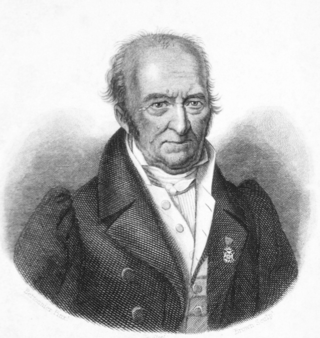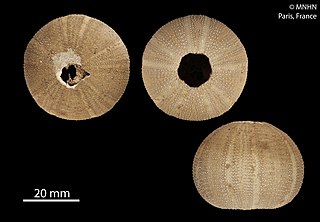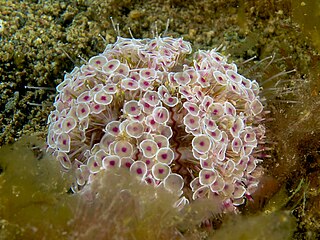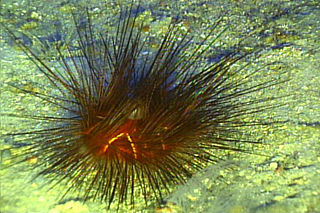
Jean-Baptiste Pierre Antoine de Monet, chevalier de Lamarck, often known simply as Lamarck, was a French naturalist, biologist, academic, and soldier. He was an early proponent of the idea that biological evolution occurred and proceeded in accordance with natural laws.

Pierre André Latreille was a French zoologist, specialising in arthropods. Having trained as a Roman Catholic priest before the French Revolution, Latreille was imprisoned, and only regained his freedom after recognising a rare beetle species he found in the prison, Necrobia ruficollis.

Henri Marie Ducrotay de Blainville was a French zoologist and anatomist.

The Diadematidae are a family of sea urchins. Their tests are either rigid or flexible and their spines are long and hollow.

Astropyga radiata, the red urchin, fire urchin, false fire urchin or blue-spotted urchin, is a species of sea urchin in the family Diadematidae. It is a large species with long spines and is found in the tropical Indo-Pacific region. It was first described in 1778 by the German naturalist Nathaniel Gottfried Leske.

Eucidaris tribuloides, the slate pencil urchin, is a species of cidaroid sea urchins that inhabits littoral regions of the Atlantic Ocean. As a member of the basal echinoid order Cidaroida, its morphological, developmental and molecular genetic characteristics make it a phylogenetically interesting species.

Varicospira is a genus of sea snails, marine gastropod mollusks in the family Rostellariidae within the Stromboidea, the true conchs and their allies.

Amblypneustes ovum is a species of sea urchin of the family Temnopleuridae. Their armour is covered with spines. It is in the genus Amblypneustes and lives in the sea. Amblypneustes ovum was first scientifically described in 1816 by Jean-Baptiste de Lamarck.

Amblypneustes pallidus is a species of sea urchin of the family Temnopleuridae. Their armour is covered with spines. It is in the genus Amblypneustes and lives in the sea. Amblypneustes pallidus was first scientifically described in 1816 by Jean-Baptiste de Lamarck.

Toxopneustes is a genus of sea urchins from the tropical Indo-Pacific. It contains four species. They are known to possess medically significant venom to humans on their pedicellariae. They are sometimes collectively known as flower urchins, after the most widespread and most commonly encountered species in the genus, the flower urchin.

Eucidaris is a genus of cidaroid sea urchins known as slate pencil urchins. They are characterised by a moderately thick test, a usually monocyclic apical disc, perforate and non-crenulate tubercles and nearly straight ambulacra with horizontal pore pairs. The primary spines are few and widely spaced, stout with blunt flat tips and beaded ornamentation and the secondary spines are short and apressed. They originated in the Miocene and extant members of the genus are found in the tropical Indo-Pacific Ocean, East Pacific, Atlantic Ocean and Caribbean Sea.

Astropyga magnifica is a species of sea urchin of the family Diadematidae. In life, their test is covered with spines. Astropyga magnifica was first scientifically described in 1934 by Austin Hobart Clark.
Astropyga nuptialis is a species of sea urchins of the family Diadematidae. Their armour is covered with spines. Astropyga nuptialis was first scientifically described in 1958 by Tommasi.

Cassidulus caribaearum is a species of sea urchins of the family Cassidulidae. Their armour is covered with spines. Cassidulus caribaearum was first scientifically described in 1801 by Jean-Baptiste de Lamarck.

Toxopneustes maculatus is a rare species of sea urchin found in the Indo-West Pacific.

Homotrema rubrum is a colonial foraminifer. It was originally discovered by Jean-Baptiste Lamarck. It is a strong red in colour. It grows on coral rubble found on the reef crest in tropical waters. Ground by the surf into sand-sized pieces, it is what gives Bermuda beaches a pink tint.

Priapulus caudatus known as the cactus worm, is a marine invertebrate belonging to the phylum Priapulida. It is a cylindrical, unsegmented worm which burrows in soft sediment on the seabed. It has a circumpolar distribution.

Parechinus angulosus, the Cape urchin, is a sea urchin in the family Parechinidae endemic to southern Africa. It is the only species in the genus Parechinus.

Fibularia is a genus of echinoderms belonging to the family Fibulariidae. The genus has almost a cosmopolitan distribution.


















